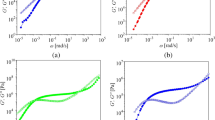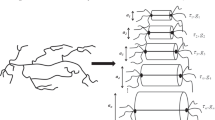Abstract
Molten LLDPE and HDPE plates (thickness 2 mm) have been inflated into a circular cylinder (inner radius 31 mm) under isothermal conditions. Low deformation rates allow the plates to be inflated considerably into the cylinder, and at high inflation rates an early burst is observed.
Axis-symmetric numerical simulation of the inflations have been performed, using a constitutive equation in the form of a separable memory integral where the strain dependence is described by the Linear Molecular Stress Function (L-MSF) model with dissipative convective constraint release. The material parameters in the constitutive model are obtained using liner viscoelastic (oscillatory shear) and uni-axial elongational measurements.
The numerical simulations were performed for inflation of a flat plate and a perturbed plate, where a small circular cone was removed from the centre of the surface of the plate. This was done in order to investigate the stability of the inflations. It is shown that all of the inflations are hydrodynamically unstable, though the effect on the occurrence of the burst is limited. One exception is at slow inflation, where an unexpected burst may appear as a consequence of minute deviations from an ideal flat plate. All of the numerical calculations show quantitative agreement with the experiments for a wide range of experimental conditions. This strongly suggests that the initiation of the burst is a hydrodynamic phenomenon.
The critical parameters in the inflation of molten linear polymers have been investigated using the Gel equation as a memory function (M(s)=Ans −(1+n)) and inflating the plate with a constant velocity for the top of the plate. The hydrodynamic burst in a linear polymer is mainly associated with the linear viscoelastic properties and only slightly with the non-linear strain dependence. Increased (linear) elasticity reduces the inflated volume, at the same inflation velocity, before the burst occurs. Furthermore, the critical parameter for the occurrence of the burst (whether or not the burst occurs) is related to the crossover point (G′=G″) in linear viscoelasticity.










Similar content being viewed by others
References
Bach A, Rasmussen HK, Longin P-Y, Hassager O (2002) J Non-Newton Fluid Mech 108:163–186
Bach A, Rasmussen HK, Hassager O (2003a) J Rheol 47:429–441
Bach A, Almdal K, Rasmussen HK, Hassager O (2003b) Macromolecules 36:5174–5179
Baumgaertel M, Schausberger C, Winter HH (1990) Rheol Acta 29:400–408
Currie PK (1982) J Non-Newton Fluid Mech 11:53–68
Denson CD, Gallo RJ (1971) Polym Eng Sci 11:174–176
Doi M, Edwards SF (1978) J Chem Soc Farad T 2 74:1818–1832
Doi M, Edwards SF (1979) J Chem Soc Farad T 2 75:38–54
Drazin PG, Reid WH (1981) Hydrodynamic stability. Cambridge University Press, Cambridge, UK
Hartwig K (1997) Simulation des Streckblasverfahrens und Charakterisierung des prozessrelevanten Materialverhaltens. PhD Thesis, IKV Band 62, RWTH Aachen, Germany
Hassager O, Kristensen SB, Larsen JR, Neergaard J (1999) J Non-Newton Fluid Mech 88:185–204
Joshi YM, Denn MM (2003) J Rheol 47:291–298
Kamei E, Onogi S (1975) Appl Polym Symp 27:19–46
Lamb H (1932) Hydrodynamics, 6th edn. Cambridge University Press, Cambridge, UK
Malkin AY, Petrie CJS (1997) J Rheol 41(1):1–25
Rasmussen HK (1999) J Non-Newton Fluid Mech 84:217–232
Rasmussen HK (2000) J Non-Newton Fluid Mech 92:227–243
Rasmussen HK (2002) J Non-Newton Fluid Mech 106:107–120
Rasmussen HK, Hassager O (2001) J Rheol 45:527–537
Rasmussen HK, Christensen JH, Gøttsche S (2000) J Non-Newton Fluid Mech 93:245–263
Spiegelberg SH, McKinley GH (1996) J Non-Newton Fluid Mech 64:229–267
Wagner MH, Demarmels A (1990) J Rheol 34:943–958
Wagner MH, Schaeffer J (1994) Rheol Acta 33:506–516
Wagner MH, Rubio P, Bastian H (2001) J Rheol 45:1387–1412
Winter HH, Chambon F (1986) J Rheol 30:367–382
Acknowledgements
The authors gratefully acknowledge financial support from the European Community (TMR research network Dynamics of Polymeric Liquids) and from a grant from the Danish Technical Research Council to the Danish Polymer Centre. We would also like to thank Dr. Svein Staal Eggen from Borealis in Norway for preparing and delivering the polyethylene plates to us.
Author information
Authors and Affiliations
Corresponding author
Rights and permissions
About this article
Cite this article
Rasmussen, H.K., Bach, A. On the bursting of linear polymer melts in inflation processes. Rheol Acta 44, 435–445 (2005). https://doi.org/10.1007/s00397-004-0376-5
Received:
Accepted:
Published:
Issue Date:
DOI: https://doi.org/10.1007/s00397-004-0376-5




